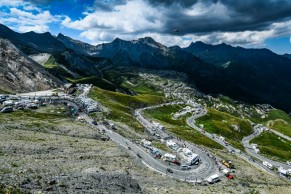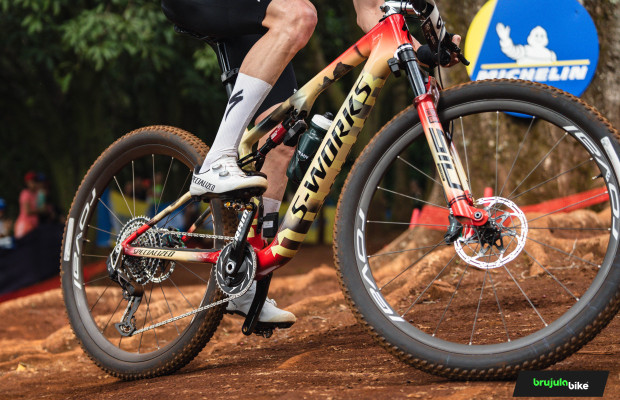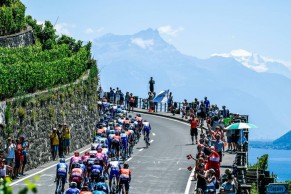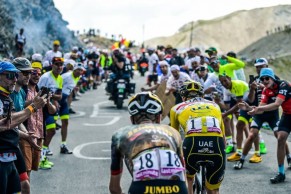Differences on how a professional and a touring cyclist climb a port
Watching a professional climbing ports in competition seems like a different sport than the one we practice. We explain all the factors that influence how mountains are tackled in a peloton and what lessons we can learn to improve our own ascents.

Climbing like a professional, beyond the watts
When we watch the big races on the calendar on television, where professional cyclists face these impressive colossi of the Alps and Pyrenees, comparing them to what we do every time we go out with our bike to pedal makes the phrase that comparisons are odious make sense.
If the race has also passed through places we usually frequent and we make the foolishness of going to Strava to compare their times with ours, we see that their performances are on another planet compared to our meager performances.
RECOMENDADO

25 cycling gifts ideas to get it right

When do helmets have to be changed? Do they have an expiration date?

Some reasons to stay away from the road in winter

S-Works: what does it really mean and where does Specialized's most exclusive label come from?

The best apps for cycling and mountain biking

Black Friday 2025 cycling bargains: save on Garmin, POC, Maxxis and more
Obviously, the power that professional cyclists are capable of moving and their optimal weight/power ratio, the famous watts per kilo that are always referred to determine performance, have a lot to do with the speed at which they can tackle the mountains. However, not everything is limited to this figure, but there are several other factors in their way of climbing the mountains and from which we can extrapolate some lessons.

The first of them is the influence of aerodynamics, an aspect that is increasingly relevant and not only in competitive cycling. Obviously, they are capable of climbing above 15 or 20 km/h, figures from which aerodynamics begins to be a factor to consider for the vast majority of ramps that are usually found on the roads.
We can also develop these speeds on more gentle slopes where, if we are looking for our best performances, it is stupid to give seconds to the stopwatch by holding on to the horizontal part of the handlebar with our backs upright or wearing the jersey open.
Also, the tactics used during the ascent have a lot to do with the way professionals tackle the mountains. On many occasions, movements occur that those who follow competitions less regularly may not understand. Like a team pushing on the approach to a mountain so that their rivals face the climb with fatigue and place their leaders in an optimal position that allows them to save efforts; or a squad protecting their leader and setting the most appropriate pace according to their requirements.

We have already mentioned the influence of aerodynamics, a factor that multiplies if we add the effect of rolling wheel to wheel with other cyclists, again, maximized by the speeds at which professional cyclists are capable of rolling in the mountains.
When we ride with companions in a group or participate in a cycling tour, we can also take advantage of this factor, saving forces if the situation requires it by wheeling with other participants or taking advantage of the help of a friend who sets the pace to attack that KOM that resists us.
However, the factor in which we can work the most to improve our own ascents is pace management, often, an aspect neglected by cyclists who let themselves be carried away by their feelings or by the obsession not to give up the group in which they ride without considering whether the pace at which they climb is within their capabilities.
Professional teams carry out an intense analysis of each stage, determining their cyclists the rhythms they must maintain in each of the ascents to reach the decisive moments of the stages with the forces as intact as possible to be able to dispute the race with all guarantees.

With the normalization of power meters, a tool increasingly common among cyclists, we can also manage the pace with total precision, not only throughout a stage but also in regard to a specific mountain.
When we ascend a known mountain, none of us have doubts about where to push and where we can recover forces. We know in detail which are the hardest ramps and what is the optimal pace we have to keep to crown without coming down.
Not knowing a mountain should not be problematic since today we can visualize it in advance with tools like Street View, know the percentages of its ramps in detail thanks to the multiple altimetry websites and even know if the wind is going to be a factor in its ascent. With all this information and knowing our power figures, we can easily calculate how long the climb will take us and, therefore, what pace we should be able to maintain.
A way of facing the mountains that technology has democratized and that, today, allows us to face a mountain stage with full guarantees of meeting our objectives.